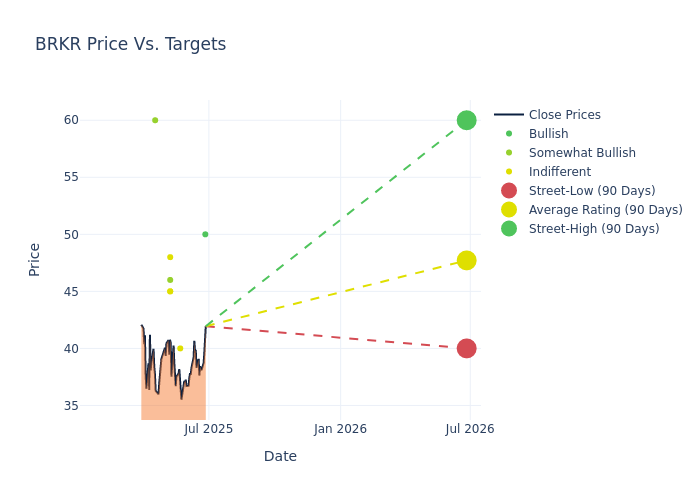
9 analysts have shared their evaluations of Bruker (NASDAQ:BRKR) during the recent three months, expressing a mix of bullish and bearish perspectives.
The following table provides a quick overview of their recent ratings, highlighting the changing sentiments over the past 30 days and comparing them to the preceding months.
| Bullish | Somewhat Bullish | Indifferent | Somewhat Bearish | Bearish | |
|---|---|---|---|---|---|
| Total Ratings | 2 | 3 | 4 | 0 | 0 |
| Last 30D | 1 | 0 | 0 | 0 | 0 |
| 1M Ago | 0 | 0 | 0 | 0 | 0 |
| 2M Ago | 0 | 1 | 4 | 0 | 0 |
| 3M Ago | 1 | 2 | 0 | 0 | 0 |
Analysts provide deeper insights through their assessments of 12-month price targets, revealing an average target of $48.22, a high estimate of $60.00, and a low estimate of $40.00. A decline of 18.88% from the prior average price target is evident in the current average.

Diving into Analyst Ratings: An In-Depth Exploration
An in-depth analysis of recent analyst actions unveils how financial experts perceive Bruker. The following summary outlines key analysts, their recent evaluations, and adjustments to ratings and price targets.
| Analyst | Analyst Firm | Action Taken | Rating | Current Price Target | Prior Price Target |
|---|---|---|---|---|---|
| Derik De Bruin | B of A Securities | Lowers | Buy | $50.00 | $61.00 |
| Patrick Donnelly | Citigroup | Lowers | Neutral | $40.00 | $50.00 |
| Dan Leonard | UBS | Lowers | Neutral | $45.00 | $57.00 |
| Luke Sergott | Barclays | Lowers | Overweight | $46.00 | $50.00 |
| Matthew Sykes | Goldman Sachs | Lowers | Neutral | $45.00 | $50.00 |
| Daniel Arias | Stifel | Lowers | Hold | $48.00 | $57.00 |
| Brandon Couillard | Wells Fargo | Lowers | Overweight | $60.00 | $75.00 |
| Luke Sergott | Barclays | Lowers | Overweight | $50.00 | $60.00 |
| Patrick Donnelly | Citigroup | Lowers | Buy | $50.00 | $75.00 |
Key Insights:
- Action Taken: Responding to changing market dynamics and company performance, analysts update their recommendations. Whether they 'Maintain', 'Raise', or 'Lower' their stance, it signifies their response to recent developments related to Bruker. This offers insight into analysts' perspectives on the current state of the company.
- Rating: Analysts assign qualitative assessments to stocks, ranging from 'Outperform' to 'Underperform'. These ratings convey the analysts' expectations for the relative performance of Bruker compared to the broader market.
- Price Targets: Analysts provide insights into price targets, offering estimates for the future value of Bruker's stock. This comparison reveals trends in analysts' expectations over time.
Navigating through these analyst evaluations alongside other financial indicators can contribute to a holistic understanding of Bruker's market standing. Stay informed and make data-driven decisions with our Ratings Table.
Stay up to date on Bruker analyst ratings.
All You Need to Know About Bruker
Bruker Corp manufactures scientific instruments and diagnostic tests for customers in the life sciences, applied markets, pharmaceutical, and biotechnology industries. The company operates in segments, namely, Bruker Scientific Instruments (BSI) BioSpin, BSI CALID, BSI Nano, and Supercon Technologies (BEST). The company generates maximum revenue from the BSI CALID segment. Geographically, it derives the maximum of its revenue from United States.
Financial Milestones: Bruker's Journey
Market Capitalization Analysis: Reflecting a smaller scale, the company's market capitalization is positioned below industry averages. This could be attributed to factors such as growth expectations or operational capacity.
Revenue Growth: Over the 3M period, Bruker showcased positive performance, achieving a revenue growth rate of 11.04% as of 31 March, 2025. This reflects a substantial increase in the company's top-line earnings. In comparison to its industry peers, the company stands out with a growth rate higher than the average among peers in the Health Care sector.
Net Margin: The company's net margin is a standout performer, exceeding industry averages. With an impressive net margin of 2.17%, the company showcases strong profitability and effective cost control.
Return on Equity (ROE): Bruker's financial strength is reflected in its exceptional ROE, which exceeds industry averages. With a remarkable ROE of 0.97%, the company showcases efficient use of equity capital and strong financial health.
Return on Assets (ROA): Bruker's ROA stands out, surpassing industry averages. With an impressive ROA of 0.3%, the company demonstrates effective utilization of assets and strong financial performance.
Debt Management: Bruker's debt-to-equity ratio stands notably higher than the industry average, reaching 1.16. This indicates a heavier reliance on borrowed funds, raising concerns about financial leverage.
Understanding the Relevance of Analyst Ratings
Analysts are specialists within banking and financial systems that typically report for specific stocks or within defined sectors. These people research company financial statements, sit in conference calls and meetings, and speak with relevant insiders to determine what are known as analyst ratings for stocks. Typically, analysts will rate each stock once a quarter.
Some analysts publish their predictions for metrics such as growth estimates, earnings, and revenue to provide additional guidance with their ratings. When using analyst ratings, it is important to keep in mind that stock and sector analysts are also human and are only offering their opinions to investors.
Breaking: Wall Street's Next Big Mover
Benzinga's #1 analyst just identified a stock poised for explosive growth. This under-the-radar company could surge 200%+ as major market shifts unfold. Click here for urgent details.
This article was generated by Benzinga's automated content engine and reviewed by an editor.